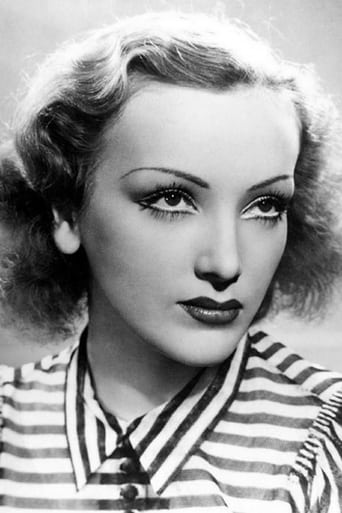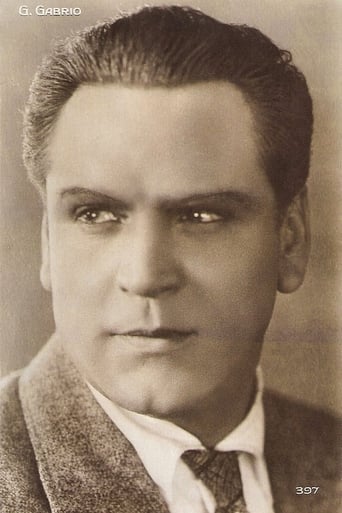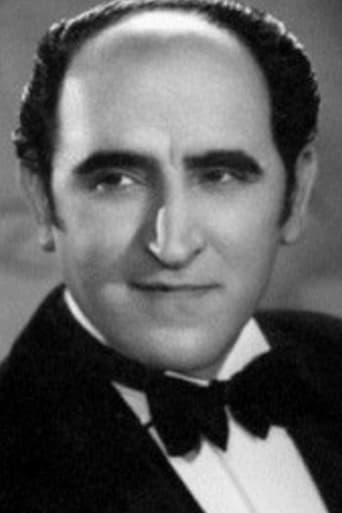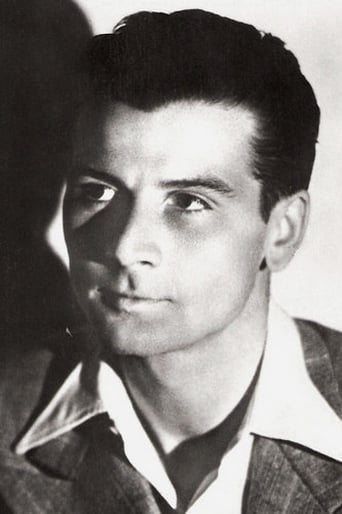Alicia
I love this movie so much
Intcatinfo
A Masterpiece!
Freaktana
A Major Disappointment
StyleSk8r
At first rather annoying in its heavy emphasis on reenactments, this movie ultimately proves fascinating, simply because the complicated, highly dramatic tale it tells still almost defies belief.
ElMaruecan82
There is no doubt "Pepe le Moko" will feel familiar to you if you already saw "Casablanca", "Morocco", "Battle of Algiers" or plain "Algiers", the remake of 1938 starring Charles Boyer. But for me, it felt familiar on a deeper level; the introductory presentation of the Kasbah opened the dusty box of my childhood memories set in the Old Medina of Rabat where we came to visit the great-grandparents, so deep I can smell it. From my own experience, I could relate to the feeling of helplessness in these labyrinthine white streets, as a child losing the firm grip of an adult's hand.And this is why "Pepe Le Moko" is such a celebrated classic, because it has the star: Jean Gabin, the character but more importantly; the location. Pepe is a gangster who slips through the Metropolitan Police net to hide in the Algerian Kasbah like French Resistance members would soon hide in the scrub to escape from Nazis. And Julien Divivier's film was released two years shy away from World War II when French police would be accessories to the most shameful pages of French history. That this film makes us root for the 'gangster' figure instead of the pitiable policemen feels like a prophetic masterstroke and a stamp for modernity. It's like Henri Jeanson, the writer, had anticipated the moment where people would root for the outlaw rather than its enforcer.In fact, this sentiment is vividly present in French cinema of the 30's, carried by the wave of poetic realism, a genre that couldn't do without slightly romanticized figures rooted in the everyday world of the 'little people'. American 'realistic' cinema was incarnated by the Warner's gangster classics but their legacy was tarnished by the narrative interference of the Hays Code. Even in French movies, crime didn't pay, but the film trusted the audience's intelligence. Realism in America made the gangster an amoral thug, a coward or a loser killing his own men, in France, the outlaw was a bad person on a social level but with layers of goodness and honor beneath. The outlaw, as portrayed by Gabin, was the quintessential tragic figure, a man who couldn't face the present without ignoring the burden of the past. And the Kasbah was the perfect place for an exile.Indeed, people of the Kasbah all have a past to bury, there's a scene that doesn't add much to the film except to show that everyone in Algiers had left something behind, an old madam burst into tears when listening to an old song about Paris, a sort of "Where all the …. Have gone?" It's hard to believe from our perspective that even in the thirties, people would be nostalgic, but nostalgia is the predominant theme in the film. Pepe is nostalgic of the Parisian streets he left, the metro stations, he's a sort of Rick Blaine who constantly reminisces about the old Paris. In fact, this is why Divivier's classic, almost 80 years now, still holds up very well today, because it embraced standards that would inspire classics, above them all: "Casablanca", and establishes staples of gangster or exotic romances: smoking and gambling crooks, corrupt cops, sneaky informants, overcrowded brothels, gold-hearted prostitutes, elegant mistresses and so on and so forth.It's a colorful gallery of characters but they aren't just archetypes, each of them is one of the many pieces of a game with the Kasbah as the chess board, as a character of its own; it gives the film its unique touch and is such an indispensable element, it inspires one of the greatest introductions from any film. When the policemen describe how tough it will be to find Pepe, it's worthy of a historical document, it has this value actually, establishing the Kasbah as a melting pot crowded with faces of all over the world, a succession of labyrinthine stairs and with the women dominating the terraces. The description reminds of Colonel Martin in "Battles of Algiers" explaining why it'll be tough to spot the terrorists, the Kasbah isn't just here to give the local flavor, it is a urbane jungle where we feel like home because we've seen "Casablanca".Yes, there's a sneaky fez-wearing cop double-dealing expert who speaks with the same hypocritically suave tone as Captain Renault, Pepe is a Blaine in terms of masculine aura and popularity, a virile tough guy who'd stick his neck out for nobody before discovering his soft spot for a classy mistress played by Mireille Balin and who's got nothing to envy from Ingrid Bergman. The thirties belonged to Gabin as only Gabin was capable to exude this manly charisma while being as gentle and tender as ever. This film is perhaps his most celebrated one at a time where he also played in Carné "Daybreaks" and Renoir's "Lower Depths". But in "Pepe Le Moko", he's in his most emblematic role in his pre-war period.And speaking of war, the film is also marked by its era through the beautiful face of Mireille Balin the Ilsa of the film, a distinguished woman, not the gypsy prostitute, that will steal Moko's heart. The actress would fall in a love with a German officer, be raped by Resistance members and then despite a few little come-back attempts, will be totally abandoned by French cinema and only one representative will assist her funeral in 1968, after she died of alcoholism, in such a miserable state she almost escaped common grave. This is a woman at the peak of her glory but would be the collateral damage of the ugliest side of French resistance: blind and violent expurgation.So, the film might be about people confronted to their past, but it carries many premonitions of the war-stricken future, it's a product of its time, of timeless appeal.
museumofdave
An amazing surprise unfolded with my first viewing of Pepe Le Moko, an amazingly atmospheric tale of a man willingly trapped by the labyrinth that is the Casbah, an attractive criminal with a flair for smart dress and a personal code that makes him a legend on the streets.There is a reason that Marlene Dietrich claimed that Jean Gabin was the only man she truly loved, and it's evident here; he's not conventionally handsome, but his honesty and intelligence shine through, and Duvivier sets up so many memorable set pieces one must return to the film again to wholly experience them: in one, a cowardly traitor falls against a player piano setting off a giddy tune while he is stalked by a dying gang member barely able to focus his gun; in another--well, experience them for yourself! This is not a conventional thriller top heavy with special effects, but a subtle examination of character taunted by the promise of a romantic future. It's a potent reminder of how important character can be in a significant story, how much more effective a good story than computer-generated effects.
chaos-rampant
Depending on your definition this is or isn't film noir, and the space inbetween explains how malleable is the term. The story has some of the elements, a hardened crook, cops on his trail, a certain karmic inescapability that is not fate, a seductive woman who is used to lure him out, a downbeat finale where the universe is not beaten.But it is important to distinguish, at least as far as the film noir debate goes, that the desired woman is not the femme fatale, and the one who actually serves as her is a heartbroken girlfriend, a traditional dramatic trope.Still so far as the karmic aspect is concerned, this is deeply noirish. Our man is holed up in the one place where police cannot find him, the Casbah of Algiers, we're taken on a tour of a place that looks very much like this man's soul, and does so throughout the film, so at once wild and sweet, teeming in the narrow streets and crowded tenements with impulsive life, love, betrayal. When he is gloomy, the whole place feels seedy and dangerous. When he's happy and singing from his balcony, the whole place erupts in cheers and song, from one sunny terrace to the next, all of them overlooking the sea promising freedom.This is karmic and not fate, not some arbitrary decree from the gods, because the prison is of his making and he's only there because his actions have brought him. He survives in the one place he has carved for himself, it is no mysterious coincidence then that he is there, in the sense that the place is very much like him.This is no idle talk either. I spent my student years in a small Aegean island of 25k people that looks exactly like the Casbah, more precisely the modern Casbah in its state of neglect. These seaside citadels are more or less the same throughout the Mediterranean, a lot of jumbled architecture without clean pattern, and were built this way to confound invaders from sea, usually saracen pirates. They were built for Pepe's purpose, that is to conceal and prevent access. In our case the invaders are French, colonists. The Casbah would soon serve as the cornerstone of Algerian liberation.There is a woman that is from there and does for him what the place does, nurtures him with wild-eyed passion, but of course he yearns for home. Another woman mirrors home, the fresh, elegant girl from Paris, he looks into her eyes and sees boulevards and cafes, the Place Blanche.You need to see this just for the finale. The claustrophobic sense of place is so pervading that when we finally step out into the harbor for the last hope of escape and our eye finally opens up, you can practically smell freedom in the sprays of sea water in the air.It is magic. He sails away on the image promising home, leaving his body behind.
alexmatte
It is widely reported that Graham Greene, usually bitingly severe when it came to film criticism, was almost lost in praise for Pepe Le Moko. This is very interesting, as he effectively wrote and screen-adapted his own even more brilliant version a decade or so later, in the form of the incomparable The Third Man (1949). Jean Gabin's Pepe's effective imprisonment in the Kasbah becomes Orson Welles' Harry Lime's own condemnation to haunt only the Russian sector and the sewers of Vienna, where the Russians can use him and the British cannot reach him. And Mireille Balin's Gaby becomes Alida Valli's Anna, respectively the direct and indirect causes for the downfall of the anti-heroes whom they love. And the sly but ruthless inspector Slimane becomes the relentless Major Calloway. And the shadows and camera-work are in spirit transported from one film to the other, as are the little poignant moments like the child on the Kasbah lane, who becomes the little boy with the ball. Another classic with strong connections to Pepe Le Moko is The Wages of Fear (1953), with Yves Montand again a Frenchman for whom Paris is the universe, trapped this time by penury in a South American backwater that he hates, with death again in the last scene providing an alternative release from such bondage. And the unorthodox, opportunist and patient tactics of inspector Slimane recall the equally ruthless brooding intensity of Major Ali Tufan in Topkapi (1964) - both lawmen getting their European men. There is a much wider lesson in this, and never more so than at this time of Western capitulation in Iraq. These films, like also the brilliant Oeil Pour Oeil (An Eye For An Eye, 1957), are typical of a very long tradition by film-makers of keenly recognising the fact that the Islamic world generally made a very bad foe, and a very good grave, for Westerners. The imperial British in Afghanistan and Rudyard Kipling as their troubadour understood exactly as much, too. They may fight opportunistically and they may fight suicidally, but in the end their overwhelming asset is that they fight at home, against displaced Westerners who are as uncomprehending as they are repelled in such alien lands. And the result is always the same, extendable by analogy to Viet Nam and other wars. Films such as all the above may be fiction, but their greatness lies in their profound observation and perspective on life and the real world. Perhaps every new government in Washington, Canberra and elsewhere should be sat down to such great examples of the cinematic art, on the off chance that they might have enough perspicacity to detect in them some of the fundamental truths that they seem to have missed via other means.




